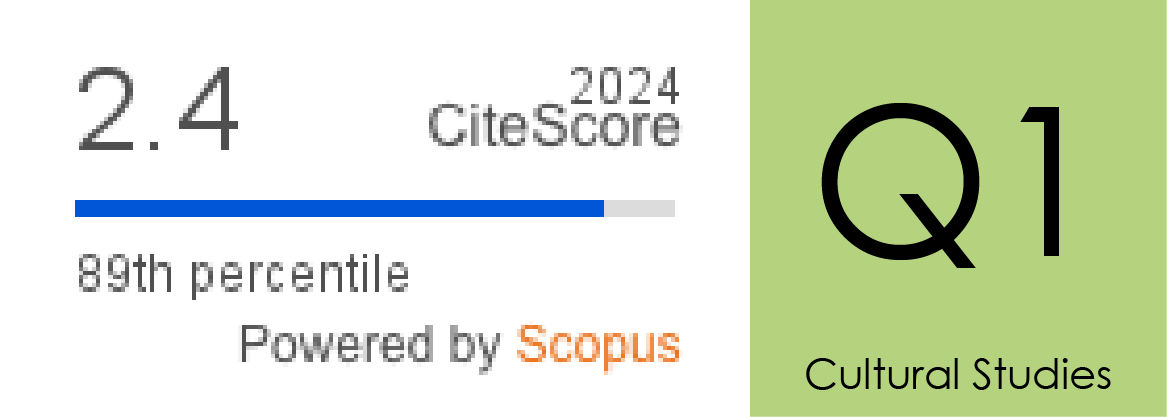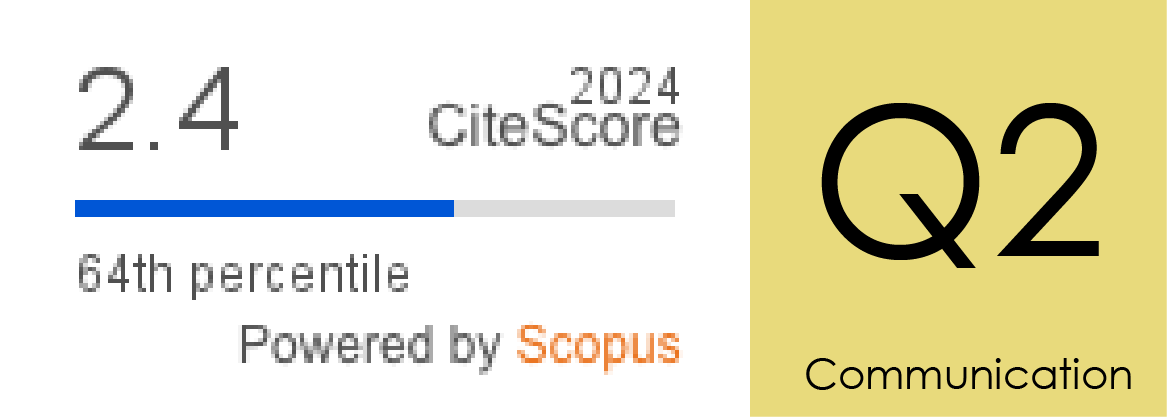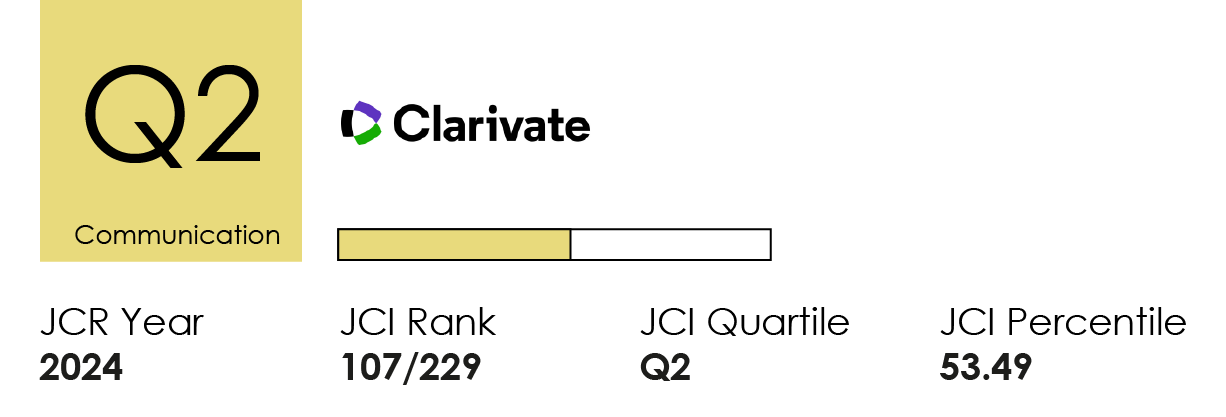Bajo el microscopio: La utilización de los medios de comunicación y los teléfonos móviles por niños y jóvenes en Portugal
DOI:
https://doi.org/10.14198/MEDCOM.27883Palabras clave:
Jóvenes, medios, niños, teléfonos móviles, usosResumen
El consumo de los medios está muy marcado por los teléfonos móviles e Internet, especialmente entre el público más joven. Aunque muchos estudios ya lo han demostrado, es importante considerar constantemente cómo se tejen las relaciones de esta población con los medios y cómo afectan a sus vidas, dados los rápidos cambios en el ecosistema mediático. A partir de un cuestionario en línea aplicado en 26 escuelas a 1,131 estudiantes de 11 a 19 años residentes en Portugal, nos propusimos examinar los medios, en particular los móviles, a un nivel microscópico. Partiendo de variables como el año de escolaridad (y la edad correspondiente) y el sexo, el análisis pretende comprender los usos de los móviles en relación con otros medios y cómo los participantes se clasifican como usuarios de ellos. Los datos demostraron que esta generación está muy implicada con los medios. El dispositivo más importante en sus vidas es el móvil, pero también Internet y redes sociales. El tiempo que pasan con el móvil aumenta con el año de escolaridad y, por tanto, con la edad. Las niñas lo utilizan más que los niños. Hay más encuestados que se consideran usuarios "intensivos" o "dependientes" del móvil que "moderados". Curiosamente, los alumnos de 6º grado (los más jóvenes) son los que más se describen como "usuarios dependientes". La dependencia del móvil queda patente cuando más de la mitad de la muestra afirma que sería el móvil que elegiría si tuviera que emprender un largo viaje y sólo pudiera llevarse un objeto.
Financiación
Fundação para a Ciência e a Tecnologia de PortugalCitas
Abeele, M. (2016). Mobile youth culture: a conceptual development. Mobile Media & Communication, 4(1), 85 –101. https://doi.org/10.1177/2050157915601455
Almeida, A., Delicado, A., Alves, N., & Carvalho, T. (2014). Internet, children and space: Revisiting generational attributes and boundaries. New Media & Society, 17(9), 1436–1453. https://doi.org/10.1177/146144481452829
Alper, M., Vikki, K., and Lynn, C. (2016) Researching children, intersectionality, and diversity in the digital age, Journal of Children and Media, 10:(1), 107-114. https://doi.org/10.1080/17482798.2015.1121886
Castells, M. (2000). The making of network society. economy, society and culture v.1: The information age. Wiley-Blackwell.
Colak, M., Bingol, O., & Dayi, A. (2023). Self-esteem and social media addiction level in adolescents: The mediating role of body image. Indian Journal of Psychiatry, 65(5). https://doi.org/10.4103/indianjpsychiatry.indianjpsychiatry_306_22
De Souza e Silva, A. (2006). From cyber to hybrid: mobile technologies as interfaces of hybrid spaces. Space and Culture 9, 261-278. https://doi.org/10.1177/1206331206289022
European Commission, Eurostat (2022). Individuals - frequency of internet use. Publication Office of the European Union. https://doi.org/10.2908/ISOC_CI_IFP_FU
Farman, J. (2016). Introduction. In J. Farman (Ed.), Foundations of mobile media studies: essential texts on the formation of a field (pp.1-15). Routledge.
Farman, J. (2015). Infrastructures of mobile social media. Social Media + Society, 1(1), 1-2.
https://doi.org/10.1177/2056305115580343
Floridi, L. (Ed.). (2015). The onlife manifesto: Being human in a hyperconnected era. Springer.
Fortunati, L. (2002). The mobile phone: Towards new categories and social relations. Information, Communication & Society, 5(4), 513–528. https://doi.org/10.1080/13691180208538803
Goggin, G. (2013). Youth culture and mobiles. Mobile Media & Communication, 1(1), 83–88.
https://doi.org/10.1177/2050157912464489
Goggin, G., & Hjorth, L. (edit.). (2008). The question of mobile media in Mobile Technologies. From telecommunications to media. Routledge.
Gui, M., Gerosa, T., Argentin, G., and Losi, L. (2023). Mobile media education as a tool to reduce problematic smartphone use: Results of a randomised impact evaluation. Computers & Education, 194:104705. https://doi.org/10.1016/j.compedu.2022.104705.
Gui, M., Fasoli, M., & Carradore, R. (2017). Digital well-being”. Developing a new theoretical tool for media literacy research. Italian Journal of Sociology of Education, 9(1), 155-173.
Horst, H., & Gaspard, L. (2021). Platforms, participation, and place: understanding young people's changing digital media worlds. In L. Green, D. Holloway, K. Stevenson, T. Leaver, & L. Haddon (Eds.). The Routledge Companion to Children and Digital Media (38-47). Retrieved from https://ezproxy.uws.edu.au/login?url= https://doi.org/10.4324/9781351004107
Jenkins, H. (2004). The cultural logic of media convergence. International Journal of Cultural Studies, 7(1), 33-43. https://doi.org/10.1177/1367877904040603
Kasesniemi, E., & Rautiainen, P. (2002). Mobile culture of children and teenagers in Finland. In Katz J. E., Aakhus M. (Eds.). Perpetual contact. Mobile communication private talk, public performance (170–192). Cambridge, UK: Cambridge University Press.
Lauricella, A., Cingel, D., Blackwell, C., B., Wartella, E. & Conway, A. (2014). The mobile generation: youth and adolescent ownership and use of new media. Communication Research Reports, 31(4), 357-364. https://doi.org/10.1080/08824096.2014.963221
Livingstone, S., Stoilova, M., & Nandagiri, R. (2019). Children’s data and privacy online: Growing up in a digital age. An evidence review. London: London School of Economics and Political Science. https://eprints.lse.ac.uk/
Livingstone, S., & Haddon, L. (2009). EU Kids Online: Final report. LSE, London: EU Kids Online. (EC Safer Internet Plus Programme Deliverable D6.5)
Lorente, S. (Ed.). (2002). Juventud y teléfonos móviles: algo más que una moda. Revista de Estudios de Juventud, 57, 9-24.
Ling, R. (2007). Children, youth, and mobile communication. Journal of Children and Media, 1(1), 60-67. https://doi.org/10.1080/17482790601005173
Marôco, J. (2021). Análise estatística com o SPSS Statistics (8.ª edição). ReportNumber.
Mascheroni, G., & Ólafsson, K. (2014). Net children go mobile: Cross-national comparisons. Report D3.3. Milano: Educatt. https://netchildrengomobile.eu/
Mun, I. (2024). A longitudinal study on the effects of parental anxiety on mobile game addiction in adolescents: the mediating role of adolescent anxiety and loneliness. International Journal of Mental Health and Addiction (2024) 22:560–577. https://doi.org/10.1007/s11469-022-00890-2
Pereira, S., Fillol, J., & Moura, P. (2021). Teens' online and offline lives: how they are experiencing their sociability. In Lelia Green, Donell Holloway, Kylie Stevenson, Tama Leaver and Leslie Haddon (Eds.). The Routledge Companion to Digital Media and Children (pp. 152-160). Routledge
Pereira, S., Moura, P., Masanet, M-J., Taddeo, G., & Tirocchi, S. (2018). Media uses and production practices: case study with teens from Portugal, Spain and Italy. Comunicación y Sociedad, 33, 89-114. https://doi.org/10.32870/cys.v0i33.7091
Ponte, C., Batista, S., & Baptista R. (2022). Resultados da 1ª série do questionário ySKILLS (2021) – Portugal. KU Leuven, Leuven: ySKILLS. http://www.fcsh.unl.pt
Ponte, C., & Batista, S. (2019). EU Kids Online Portugal. Usos, competências, riscos e mediações da internet reportados por crianças e jovens (9-17 anos). EU Kids Online e NOVA FCSH.
Sheskin, D.J. (2011). Handbook of Parametric and Nonparametric Statistical Procedures. Chapman and Hall/CRC.
Simões, J. A., Ponte, C., Ferreira, E., Doretto, J., & Azevedo, C. (2014). Crianças e meios digitais móveis em Portugal: Resultados nacionais do projeto Net Children Go Mobile. CESNOVA – Centro de Estudos de Sociologia da Universidade Nova de Lisboa. http://www.netchildrengomobile.edu
Togar, E., Antheunis, M., De Leyn, T., & Abeele, M. (2024). “I am not human without my phone”: How the socio-cultural realities of Liberia shape Liberian mobile youth culture. Mobile Media & Communication 12(1), 95-111. https://doi.org/10.1177/20501579231197373
Tufekci, Z., & Brashear, M.E. (2014). Are we all equally at home socializing online? Cyberasociality and evidence for an unequal distribution of disdain for digitally mediated sociality. Information, Communication and Society. 17 (4), 486–502. https://doi.org/10.1080/1369118X.2014.891634
Thulin, E., & Vilhemson, B. (2019). More at home, more alone? Youth, digital media and the everyday use of time and space. Geoforum 100, 41-50.
https://doi.org/10.1016/j.geoforum.2019.02.010
Thulin, E., & Vilhelmson, B., (2012). The virtualization of urban young people's mobility practices: a time-geographic typology. Geograf. Annaler B Hum. Geogr. 94 (4), 391–403. https://doi.org/10.1111/geob.12005
Valkenburg, P. M., Meier, A., & Beyens, I. (2022). Social media use and its impact on adolescent mental health: An umbrella review of the evidence. Current opinion in Psychology, 44, 58–68. https://doi.org/10.1016/j.copsyc.2021.08.017
Descargas
Estadísticas
Publicado
Cómo citar
Número
Sección
Licencia
Derechos de autor 2025 Sara Pereira, Joana Fillol, Daniel Brandão, Mariana Menezes-Neumann

Esta obra está bajo una licencia internacional Creative Commons Atribución 4.0.
Los autores y autoras que publican en esta revista están de acuerdo con los siguientes términos:
1 Derechos de autor. Los autores y autoras conservan sus derechos de autor, aunque ceden a la revista de forma no exclusiva los derechos de explotación (reproducción, distribución, comunicación pública y transformación) y garantizan a esta el derecho de primera publicación de su trabajo, el cual estará simultáneamente sujeto a la licencia indicada en punto 2. Los autores pueden establecer otros acuerdos adicionales para la distribución no exclusiva de la versión de la obra publicada en la revista, siempre que exista un reconocimiento de su publicación inicial en esta revista.
© Los autores.
2 Licencia. Los trabajos se publican en la revista sujetos a la licencia de Reconocimiento 4.0 Internacional de Creative Commons (CC BY 4.0); los términos se pueden consultar en https://creativecommons.org/licenses/by/4.0/
Esta licencia permite a terceros compartir (copiar y redistribuir el material en cualquier medio o formato) y adaptar (remezclar, transformar y crear a partir del material para cualquier finalidad, incluso comercial), siempre que se reconozca la autoría y la primera publicación en esta revista (Revista Mediterránea de Comunicación (RMC) / Mediterranean Journal of Communication (MJC), Universidad de Alicante, DOI de la obra), se proporcione un enlace a la licencia y se indique si se han realizado cambios en la obra.
3 Política de autoarchivo. Se recomienda a los autores que difundan sus trabajos a través de Internet para favorecer una circulación y difusión más rápidas y, con ello, un posible aumento en la citación y alcance entre la comunidad científica y académica, en las siguientes condiciones:
No se permite a los autores depositar en un repositorio institucional o temático, página web propia, etc., las versiones preprint (versión antes de ser evaluada) o postprint (versión evaluada y aceptada para su publicación) de sus trabajos antes de su publicación, pero sí el artículo final publicado (versión del editor).













